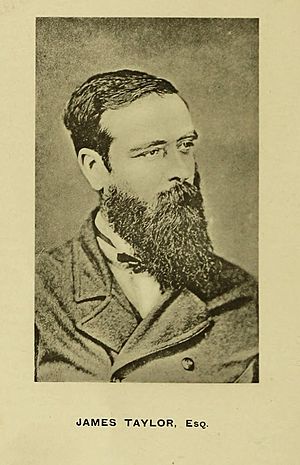James Taylor (tea planter) facts for kids
Quick facts for kids
James Taylor
|
|
|---|---|
 |
|
| Born |
James Taylor
29 March 1835 Mosspark, Auchenblae, Kincardineshire, Scotland
|
| Died | 2 May 1892 (aged 57) Kandy, British Ceylon
|
| Known for | First tea plantation to British Ceylon (Sri Lanka) |
James Taylor (born March 29, 1835 – died May 2, 1892) was a Scottish tea farmer. He is famous for bringing tea growing to British Ceylon (now called Sri Lanka). Taylor arrived in Ceylon in 1852. He made his home at the Loolecondera estate. There, he worked with another Scottish businessman, Thomas Lipton. Together, they helped build the tea industry in Ceylon. Taylor lived in Ceylon for most of his life, until he passed away.
Contents
James Taylor: The Tea Pioneer
Life at Loolecondera Estate
In 1866, Taylor visited India. He went there to learn how to grow tea on large farms. After returning, he started a tea farm at the Loolecondera estate in Kandy, Sri Lanka.
He began his tea plantation on a small area, about 19 acres, in 1867. By 1872, he had built a complete tea factory on the Loolecondera estate. While Taylor lived there, tea exports grew a lot. They went from 23 pounds to 81 tonnes. By 1890, exports reached an amazing 22,900 tonnes.
Building a Tea Business
In 1872, Taylor started building a bigger tea factory. He also began making tea that was already packed. He wrote about his success with the new factory. He mentioned having "a machine of my own invention" for rolling tea. He believed it would work well.
By 1875, Taylor sent the very first shipment of Ceylon tea to the London Tea Auction. This was a big step for the tea industry in Ceylon.
Working with Thomas Lipton
Thomas Lipton was a very rich businessman from the United Kingdom. In the 1890s, he visited British Ceylon (Sri Lanka). He was on his way to Australia when he met James Taylor.
They talked about the business of sending tea from Ceylon to other countries. Lipton's company became very interested. They soon started buying large amounts of Ceylon tea. This partnership helped Ceylon tea become famous worldwide.
Taylor's Legacy and Passing
The tea industry in Ceylon grew very quickly. Because of this, large tea companies began to take over. Smaller farmers, like Taylor, found it hard to compete. Sadly, Taylor was eventually let go by the Loolecondera estate management.
Taylor passed away in 1892, a year after he was dismissed. He was buried in the Mahaiyawa Cemetery in Kandy. His headstone honors him as "the pioneer of the cinchona and tea enterprise in this island."
The day after he died, Taylor's body was carried from the Loolecondera estate to the cemetery. Estate workers carried him for 18 miles. They did this to show their respect for his efforts in starting the tea industry.
A year after his death, in 1893, one million packets of Ceylon tea were sold. This happened at the Chicago World's Fair.
For many years, British companies owned most tea estates in Sri Lanka. This continued until 1971. That year, the Sri Lankan government took ownership of the tea estates.
Honoring James Taylor
In 1992, people marked 100 years since Taylor's death. John Field, a UK official, spoke about him. He said Taylor's work helped shape the beautiful landscape of Sri Lanka's hill country. A museum was also built in 1992 where Taylor used to live. This museum honors his memory.
On June 29, 2019, a statue of James Taylor was unveiled. It was placed in Auchenblae, Scotland, where he was born. The statue was designed by Prof. Sarath Chandrajeewa. It was a gift from Mr. Anselm Perera of Mlesna Teas, Sri Lanka. The statue stands overlooking the Auchenblae Village Square.
Images for kids



